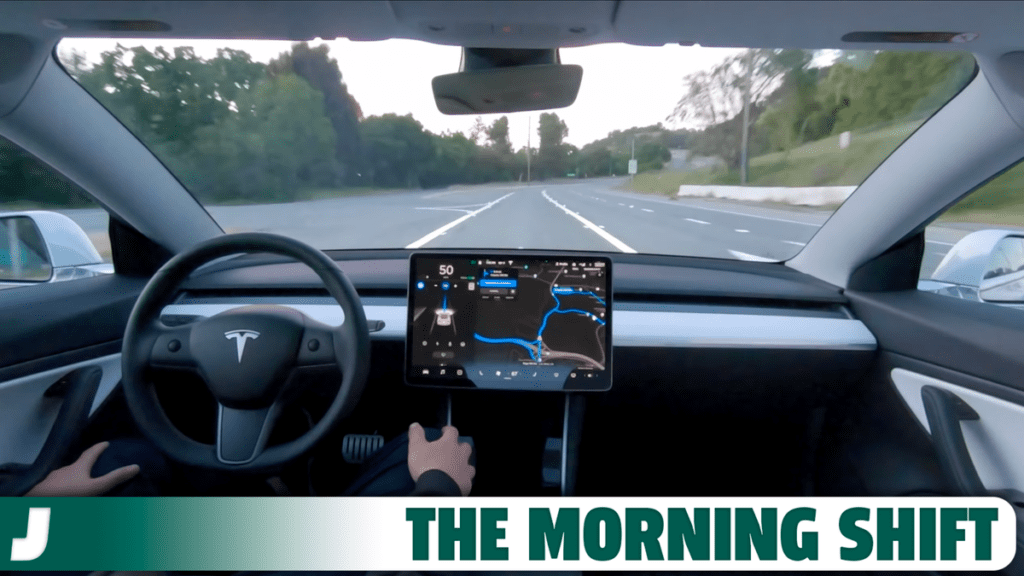Tesla’s Autopilot Recall Probably Won’t Fix The Problem: Critics

Good morning! It’s Thursday, December 14, 2023, and this is The Morning Shift, your daily roundup of the top automotive headlines from around the world, in one place. Here are the important stories you need to know.
1st Gear: Critics Say Autopilot Recall Won’t Fix The Issue
Tesla’s decision to recall over 2 million of its vehicles with Autopilot during a federal probe may not have gone far enough to make sure drivers are actually paying attention, according to some critics.
The Austin, Texas-based automaker was forced to recall just about every car with Autopilot after a two-year investigation by the National Highway Traffic Safety Administration determined the system doesn’t do enough to stop drivers from misusing it. Before you say anything, yes, I know it was an over-the-air update. That still counts. From Bloomberg:
“It’s a good initial step, but there’s a lot that still needs to be done,” said Mary “Missy” Cummings, a George Mason University professor who has been critical of Tesla’s automated-driving systems.
[…]
Among the potential changes Tesla could make is moving to a system where drivers are required to have good driving scores on their internal monitoring system to get access to Autopilot, Cummings said. And she said drivers shouldn’t be able to use it in areas it’s not designed for, like city streets.
Michael Brooks, executive director of the Washington-based Center for Auto Safety, said he was “glad that Tesla appears to be putting additional restrictions” around where and when Autopilot can be enabled, as well as adding more warnings.
But, he said, “there don’t appear to be any answers or fixes relating to the system’s repeated failures to detect and respond to emergency personnel and other related hazards.”
William Wallace, associate director of safety policy at Consumer Reports, said Tesla took too long to conduct a recall.
“Tesla should have launched a broad recall for Autopilot at least five years ago, and delays like this are unacceptable,” Wallace said in an emailed statement. “We credit NHTSA for its perseverance, but it’s clear the agency needs a greater practical ability to force recalls when a company drags its feet.”
US Senators Richard Blumenthal and Edward Markey, Democrats from Connecticut and Massachusetts, respectively, said in a statement the Autopilot recall was “egregiously overdue.” The senators urged NHTSA to “continue its investigations to spur necessary recalls, and Tesla to stop misleading drivers and putting the public in great danger.”
The over-the-air update includes additional controls and alerts that are supposed to make Autopilot safer. If I had to guess, these updates will be the absolute minimum to get it to pass U.S. regulations, as is the Tesla tradition.
2nd Gear: Nine Cruise Execs Fired After Safety Probe
General Motors’ Cruise robotaxi business gave nine key people the boot amid an ongoing safety investigation. That includes the company’s CEO, Gil West. The investigation itself relates to the October 2 incident where a woman was struck and dragged down the street by a Cruise vehicle in San Francisco. From Reuters:
The shakeup follows weeks of turmoil at the robotaxi unit, which had to pull all its vehicles from testing in the United States to conduct a safety review after the accident. CEO Kyle Vogt and co-founder Dan Kan both resigned in recent weeks and Cruise is preparing for a round of layoffs this month.
“Following an initial analysis of the October 2 incident and Cruise’s response to it, nine individuals departed Cruise,” according to the memo.
“We are committed to full transparency and are focused on rebuilding trust and operating with the highest standards when it comes to safety, integrity, and accountability,” the memo said. “As a result, we believe that new leadership is necessary to achieve these goals.”
The Cruise spokesperson confirmed that among those dismissed was also Chief Legal and Policy Officer Jeff Bleich and Senior Vice President of Government Affairs David Estrada.
These firings, and trouble at Cruise as a whole, serve as a setback for the robotaxi industry that depends on public trust and the cooperation of regulators. Until recently, Cruise had some big plans to expand to more cities.
The investigation, led by law firm Quinn Emmanuel, is expected to last until January, GM has said.
“The personnel decisions made today are a necessary step for Cruise to move forward as it focuses on accountability, trust and transparency,” GM said in a statement.
In October, the California Department of Motor Vehicles ordered Cruise to remove its driverless cars from state roads, calling them a risk to the public and saying the company had misrepresented the safety of its technology.
Further, the National Highway Traffic Safety Administration in October opened an investigation into pedestrian risks at Cruise.
Cruise could face $1.5 million in fines and additional sanctions over its failure to disclose details surrounding the accident, a California agency has said.
Cruise’s new president, who took over last month, apparently said at an all-hands meeting that the company was at an “all time low.” Yeah bud, you think?
3rd Gear: McLaren Switches To Order-Based Allocations
McLaren is shifting to a customer order-based dealer allocation model in North America. Under the new system, McLaren’s 29 dealers in the U.S. and Canada will primarily receive customer-ordered vehicles rather than a predetermined stock of cars on the lot. From Automotive News:
“We are placing an emphasis on getting the right balance of demand and supply,” McLaren Americas sales boss Geoff Tink told Automotive News. “We will allocate inventory to those dealers that show demand in the form of customer orders and effectively provide our allocation to the places where it’s needed the most.”
The new distribution strategy is a sign of a maturing business.
[…]
The executive said the British brand initially allocated vehicles to dealers based on a “perception of demand” based on market research.
“Sometimes that was accurate, and sometimes it wasn’t,” Tink said. “We freely admit that we may have made some mistakes early on.”
McLaren’s pivot to an order bank-focused supply model occurs as the brand sees a surge in demand for bespoke vehicles. Up to 80 percent of new-car sales in the U.S. are custom orders — more than double what it was pre-pandemic.
McLaren’s latest facility upgrade program for dealerships reflects the trend. Commissioning areas, where customers can go through options to spec out a vehicle, are a focal point of the new design. Some stores have a “Woking Window,” a video feed of the McLaren Production Center in Woking, England.
McLaren said the new allocation system “creates flexibility, drives retailer profitability and rewards good customer experience.”
We [can] more closely prioritize sending new inventory to our top-performing dealers,” Tink said. “But we can also adjust to economic and geographical factors as they evolve over the course of the year.”
[…]
Customer order-based supply means retailers are less likely to get stuck with unsold vehicles — an expensive proposition in today’s high-interest rate climate.
Still, McLaren will let its dealers stock up on popular vehicles, like the Artura and GT, to account for walk-in business. That’s the American way, baby.
4th Gear: Nissan Boosts Ariya EV Production
Nissan says its new Intelligent Factory, where the Ariya electric crossover is built, is finally running smoothly after a rough couple of years that really hurt the EV’s production. From Automotive News:
The high-tech line is operating at only two-thirds capacity. To boost efficiency, Nissan is considering adding another vehicle and even looking at introducing advanced gigacasting, said Eiji Kikuchi, manager of the Tochigi Plant that houses the Nissan Intelligent Factory line and a separate legacy line making other models.
“It’s underutilized — we have more capacity,” Kikuchi said on a Dec. 8 tour of the site. “It’s a totally new factory with totally new processes. We had many headwinds.”
Nissan warned U.S. dealers earlier this year that supply of the flagship Ariya would be limited, even after its much-delayed rollout. At one point, the new nameplate was scheduled to debut in mid-2021. But deliveries of the base model Ariya began in Japan only in May 2022. Nissan told U.S. dealers then to stop placing orders for the vehicle amid tight supply.
But now, the factory is humming along and able to keep up with demand, Kikuchi said.
With newfound confidence in troubleshooting, Nissan plans to spread its advanced technology to other facilities that will build the company’s next generation of EVs. The technologies used at Tochigi likely preview those planned for Nissan’s Canton, Miss., plant, which is being retooled to make four new EVs for the U.S. market from around 2026.
From April to October, the first seven months of Nissan’s fiscal year, the Intelligent Factory built 25,280 vehicles, and 26,900 of them were Ariya electric crossovers.
Reverse: It’s Chilly
Neutral: One Fast Son Of A Bitch
2024 BMW i5 M60 | First Drive
On The Radio: Boston – “More Than A Feeling”
Boston – More Than a Feeling (Official HD Video)




